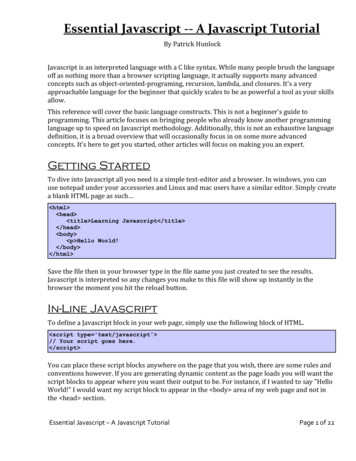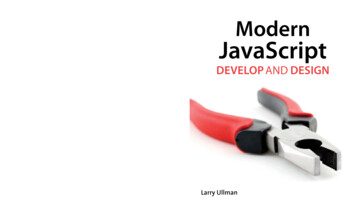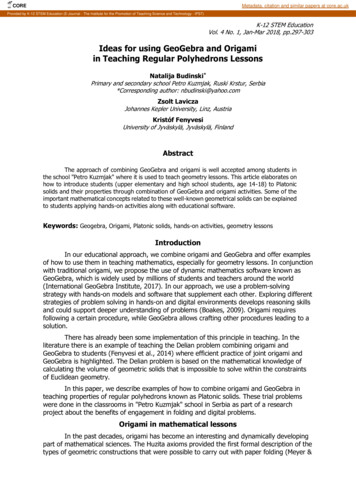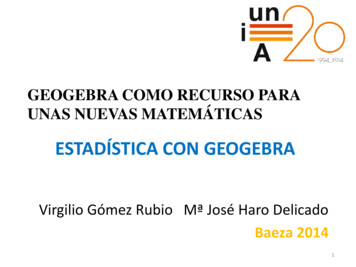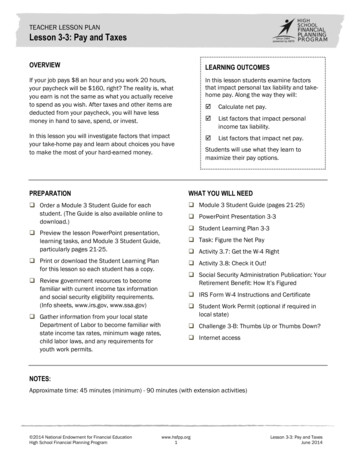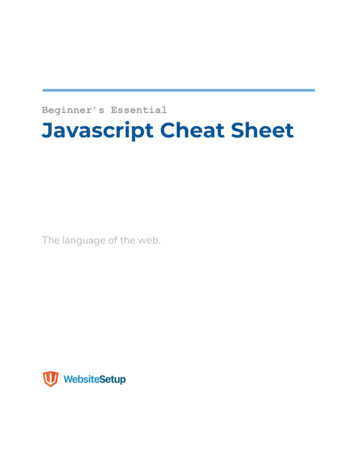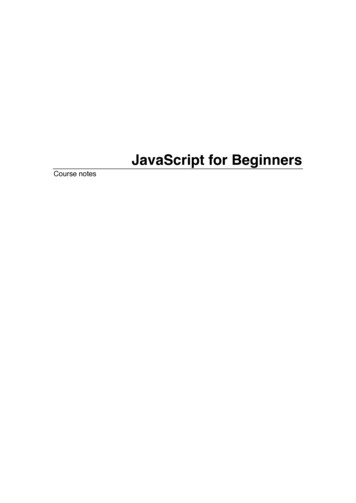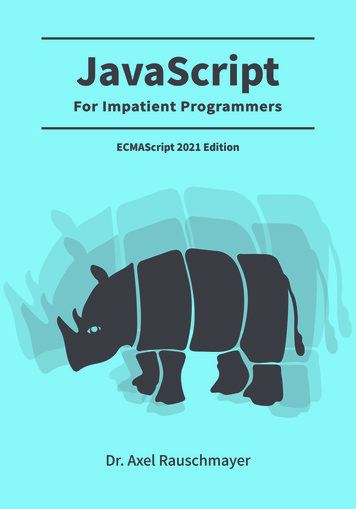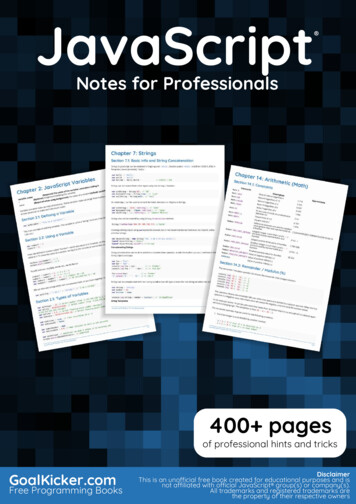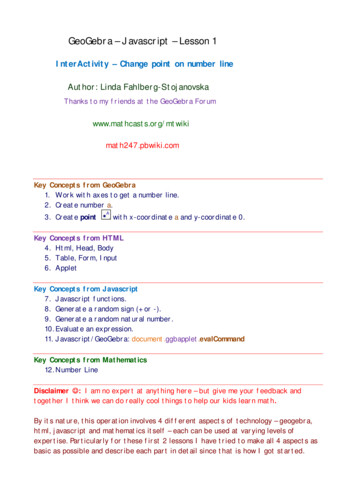
Transcription
GeoGebra – Javascript – Lesson 1InterActivity – Change point on number lineAuthor: Linda Fahlberg-StojanovskaThanks to my friends at the GeoGebra Forumwww.mathcasts.org/mtwikimath247.pbwiki.comKey Concepts from GeoGebra1. Work with axes to get a number line.2. Create number a.3. Create pointwith x-coordinate a and y-coordinate 0.Key Concepts from HTML4. Html, Head, Body5. Table, Form, Input6. AppletKey Concepts from Javascript7. Javascript functions.8. Generate a random sign ( or -).9. Generate a random natural number.10. Evaluate an expression.11. Javascript/GeoGebra: document.ggbapplet.evalCommandKey Concepts from Mathematics12. Number LineDisclaimer : I am no expert at anything here – but give me your feedback andtogether I think we can do really cool things to help our kids learn math.By its nature, this operation involves 4 different aspects of technology – geogebra,html, javascript and mathematics itself – each can be used at varying levels ofexpertise. Particularly for these first 2 lessons I have tried to make all 4 aspects asbasic as possible and describe each part in detail since that is how I got started.
Script-o-maticGeoGebra1. Create geogebra file with number line.a. Open new geogebra file.b. If not open, open the algebra window (View - Algebra Window).c. We want to turn off the y-axis.i.Right-click in graphics view (a.k.a. drawing pad) and choose Properties.ii.Drawing box dialog box will open.Click on yAxis tab and then deselect Show yAxis. Click on Close.d. We want move the x-axis up towards the top and zoom out.i.Click on the “Move graphics view” iconand then click and drag the xaxis towards the top.ii.With this icon selected, you should be able to use your mouse wheel tozoom in/out. We want the number line to be from -10 to 10 since we willgenerate this “size” of numbers in our script.Note:When programming, we want the Algebra window to be visible so we cancheck the interaction. When done, we will usually close the Algebrawindow which gives the user a larger graphics view.For now we will “use” a ggb window of standard width 1024px (I use afreebie program called sizer to get this) with an open Algebra windowand plan my width to under the minimize button. (Then when theAlgebra window is closed, this will fit in my webpage width 690px.)iii.You can fix the increments, tick marks, etc. of the x-axis.However, if you want your user to be able to zoom in/out, don’t do thisbecause geogebra cannot then automatically adjust.
2. Make a starter number a and point A (a,0) on number line.a.Click in the input field, type or copy/paste a 4 and hit enter.(If you don’t see Input, command View - Input bar.)b. Your cursor is still in input field. Type or copy/paste A (a,0) and hit enter.3. Decorate point Aa.Turn off the label on this point and make it bigger and a distinctive color.(Right-click on the point and choose properties from drop-down menu.On the basic tab, deselect “Show label”, on the style tab, move the slider to5 and on the color tab, choose your favorite color.)b. Here is what our geogebra file looks like so far.Note:From the webpage we will be changing the value of the number a. Thiswill automatically change the value of the point A and its position on thenumber line.4. Save your geogebra file as numberline js.ggb.Webpage5. Our webpage has 3 main parts.a. It has a text-html part with instructions and “form” for user input.b. It has a geogebra part with the “applet” part that looks for and then opensand displays the geogebra file.c. It has a javascript part with the “function” for generating a new point onthe number line and for communicating with the geogebra file. (In the nextlesson, we will add another function to check whether the user has correctlyidentified the point value.)Parts a and b are visible - that is, the user will see the text and the geogebra file.Part c is invisible to the user.
Webpage – html partThe text in the box is non-visible html code. All browsers (firefox, internet explorer)know how to read this code.Open a new file in a text editor (notepad) and copy and paste this text into it.Or, if you use an html editor (dreamweaver, alleycode), first switch to code-view,erase all the code there (most editors automatically generate the required parts ofthis code plus some of their own) and then copy and paste in this code.Save the file as numberline js.html in the same folder as numberline ---------------All none-shaded lines in the box are REQUIRED. You may change the green text – this is the title of the webpage itself . The shaded stuff between the style tags is optional.It is formatting directions to make the text small enough so there is space for the geogebra file and tomake sure that Firefox changes its cursor to a hand over the input button.The actual content (parts a, b and c) will come between the body tags. !DOCTYPE HTML PUBLIC "-//W3C//DTD HTML 4.01 Transitional//EN" html head meta http-equiv "Content-Type" content "text/html; charset utf-8" title GeoGebra/Javascript 1 - Number Line /title style type "text/css" !—body{font-family:Helvetica,sans-serif; margin-left:0px; }p,ul,ol{font-size:.7em; margin-top:3px; margin-bottom:3px;}/* cursor changer for Mozilla Firefox */.navCurOff{cursor: default;}.navCurOn{ cursor: pointer; cursor: hand;}-- /style /head body HERE WE PUT CONTENT OF PAGE – IN THE BODY /body /html If you open this file in your browser, it will only have the 1 line: HERE WE PUT
BODY Part a and Part b – Visible textWhat will our page look like?While we are working (open Algebra window so extra width of 300):When we are done (fits on 1024x790 resolution with closed Algebra window):Notice the table on this page:A table is a good way to organize the content of a webpageHere the top row spans two columns and contains text-title.The second row has two columns – the instruction column and the ggb page column.Instructions has a paragraph, a horizontal line, a paragraph, and an Input Button.Teal text - notice it spans 2 columnsBlue textOrange textInput ButtonGeoGebra file
So – the visible part of page is put in a table between table tags.Idea is a simple table of width 1000px so it fits on a standard monitor resolution in astandard browser (firefox or internet explorer). I usually make my instruction column300px wide and my GeoGebra column 690px wide with 10px leftover for borders.While we are working we will add 300px to 1000px and to 690px (2 places!) for thealgebra window. When we are done, we go back to 1000 and 690. table border "1" width "1300" tbody tr td colspan "2" GeoGebra/Javascript 1 - Make New Point on Number Line /td /tr tr td width "300" p b Goal: /b Create form and javascript function to let usergenerate and send data from webpage to GeoGebra file. /p hr p 1. Generate a new point - click on the New Point button. /p form input name "button" type "button" class "navCurOff"onClick "gensetInt('a',10);" onMouseOver "this.className 'navCurOn';"onMouseOut "this.className 'navCurOff';" value "New Point" /form p /p p /p /td td width "990" applet name "ggbApplet" code "geogebra.GeoGebraApplet" codebase "./"archive "http://www.geogebra.org/webstart/geogebra.jar" height "150"width "990" param name "filename" value "numberline js.ggb" param name "showAlgebraInput" value "false" param name "showMenuBar" value "false" param name "showToolBar" value "false" param name "showResetIcon" value "true" Sorry, the GeoGebra Applet could not be started. Please make sure that Java1.4.2 (or later) is installed and activated. ( ahref "http://java.sun.com/getjava" click here to install Java now /a ) /applet /td /tr /tbody /table You can copy and paste this text between the body tags in your numberline js.htmlfile and save it again. (Delete the HERE WE PUT .)If you now open this file in your browser, you should see the “working version”.Don’t click on the Input Button – we haven’t defined the javascript function.
The two “important” parts here are the FORM and the APPLET1. The form form input name "button" type "button" class "navCurOff"onClick "gensetInt('a',10);" onMouseOver "this.className 'navCurOn';"onMouseOut "this.className 'navCurOff';" value "New Point" /form Most of this stuff is “formatting”, but it uses the html style stuff (from the firstpart of the html code) to make the cursor change to a pointer or hand when themouse rolls over the button so that one “knows” it is clickable.type says that input is a button you click on (and not e.g. text you type in).value says button name is “New Point” (this is text that you can change).onClick says – when the user clicks on the button – the page should run thejavascript function “gensetInt(‘A’,10)”.2. The applet applet name "ggbApplet" code "geogebra.GeoGebraApplet" codebase "./"archive "http://www.geogebra.org/webstart/geogebra.jar" height "150"width "690" param name "filename" value "numberline js.ggb" param name "showAlgebraInput" value "false" param name "showMenuBar" value "false" param name "showToolBar" value "false" param name "showResetIcon" value "true" Sorry, the GeoGebra Applet could not be started. Please make sure thatJava 1.4.2 (or later) is installed and activated. ( ahref "http://java.sun.com/getjava" click here to install Java now /a ) /applet archive says where to find the files that will run geogebra – when 3.2 isreleased (in February 2009), dev/unpacked/ should be deleted. (This is typical,but it also means one must be online to run the applet. More about this later .)width is the width of the display of the ggb file. Match width of table column.height is the height of the display of the ggb file. (I added to blank rows in theleft column p /p to compensate for this height.)filename is the name of the ggb file. Notice no path means that this html fileand the ggb file must be in the SAME folder.showAlgebraInput, showMenuBar, showToolBar are whether input field,command menu and icon tool bar are shown with the geogebra file.(Showing these on the page is a matter of space and whether you want yourstudents to use them. False is default value so all three lines can be deleted.)showResetIcon is whether you get the reset icon to be able to reload ggb.
BODY Part c - JavascriptThe javascript part of the page is put between script tags. script type "text/javascript" //function gensetInt(objName,rang) {// generates random plus and minus signvar sgn1 2*Math.floor(Math.random()*2)-1;// generates random integer between 1 and rang - use floor to get 0 to rang-1var n1 Math.ceil(Math.random()*rang);var z sgn1*n1;document.ggbApplet.evalCommand(objName " " z);}// /script Usually one puts the javascript at the the end – just above the /body of the html.Copy and paste this text into your numberline js.html file and save it.6. When the user clicks on the New Point button, the above javascript function willbe called using the command gensetInt(‘a’,10).Two parameters are passed into the function.The 1st is objName ’a’ (text) and the 2nd is rang 10 (number).javascript math functions:o Math.random() generates a random number between 0 and 1o Math.floor(number) finds the largest integer numbero Math.ceil(number) finds the smallest integer numbergeogebra/javascript function:o document.ggbApplet.evalCommand(legitimate ggb input)where javascript variables are separated by and text by “.Mixing of text and numbers is allowed.Here, let’s assume we generated z -3. We were given objName ’a’.objName " " z means a -3So the function gensetInt(objName,rang) willrandomly generate sgn1 a sign ( or -),randomly generate a natural number n1 between 1 and rang 10,multiply these to get z andset a z in numberline js.ggbIn numberline js.ggb automatically,a. the number a will take on the value zb. the point A will change to (z,0) andc. the purple point will move to z on the number line.While “working”, we keep the Algebra window open so we can see all of these changes.
7. Let’s try it!Open numberline js.html in your browser.Roll your mouse over the New Point button. Check cursor changes to a pointer.Now click on the New Point button. In the algebra window, you should see a and(then) A change and in the graphics view, the purple point should move.(First time may take a moment.)Click on the New Point button again to see it generate a new point.When you are satisfied that all is working,in GEOGEBRA close the Algebra window and re-save numberline js.ggbin text/HTML editor, change 1300- 1000 and 990- 690 (2 times) and re-savenumberline js.htmlReload numberline js.html in your browser.If the algebra window still shows open, you may need to close all instances of yourbrowser to clear your cache (so it reloads the newly saved ggb file).Now, when you click on the New Point button only “c” will be visible to the user – thatis, the user see a new point on the number ------------------------------------------------A couple of javascript hints:// (two forward slashes) is a comment line in javascript. Comment everything.Sections of code are separated by { } and individual lines of code in a sectionend with a semi-colon ; indenting is a good way to keep sections separate.We can and will have more than one javascript function between script tags.Javascript is case sensitive. Try and be consistent about capitalization.Javascript is extremely unforgiving of missing punctuation.Save yourself a lot of time. Write and check each section of code individually.I use the code line: alert(“Here1”); to see where I am stuck.Unlike most programming languages, it is hard to get parameters out of ajavascript function. We will use global variables.A couple of html hints:A good free html editor – http://www.alleycode.com/download.htm (use Ctrl Dto switch between code view and wysiwyg).Blanks (spaces or rows) mean NOTHING in html. (This text will only have 1space between eachword. The extras are thrown away.)o To add blank spaces, use the code for a “non-breaking space” o To add blank row, use the code for “break row” br / Learn to close all your tags – e.g. tr starts a table row. When you are donewith the row, type /tr . Most good editors have code checkers.
What the html file looks like in Dreamweaver (color-coded code)
Key Concepts from Javascript 7. Javascript functions. 8. Generate a random sign ( or -). 9. Generate a random natural number. 10.Evaluate an expression. 11. Javascript/GeoGebra: document.ggbapplet.evalCommand Key Concepts from Mathematics 12.Number Line Disclaimer-: I am n
